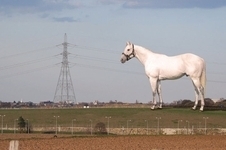An interview in yesterday’s Guardian with Rachel Whiteread is headlined ‘Will Rachel Whiteread, unshowy as she is, be the Britartist who stands the test of time? As her haunting new work is unveiled, Simon Hattenstone reports’. When I read this I did a double take – haunting new work? Then I realised it was referring to an installation based on her collection of dolls houses, rather than her proposal for the Ebbsfleet landmark, which Adrian Searle strongly criticised earlier in the week: ‘Rachel Whiteread's concrete cast of the interior of a house - apparently one she used to live in - stands on a fake mountain replete with chalk escarpments, romantic crags and overhangs. It will be built from the recycled rubble of the emerging new town. I wish she hadn't done this. The whole thing feels recycled and unnecessary, and actually diminishes Whiteread's most famous sculpture, her 1993 House in east London.’ Still, the fact that Whiteread is up for this does suggest we’ve come a long way since Tower Hamlets council demolished House – an action which reminds me of those people who scrub off some Banksy graffiti only to realise they’ve inadvertently thrown away a whole lot of money...
Like Georges Perec in his Species of Spaces, Whiteread has worked her way outwards from the most intimate space of the bed, to the room, to the house and beyond to spaces in the wider world. Now the demands of scale (the Ebbsfleet commission was to make something bigger than the Angel of the North) have taken her a step beyond site specific constructions like the Holocaust Monument in Vienna and into the realm of land art. The use of rocks and rubble in her Ebbsfleet proposal points directly to the work of Robert Smithson. As Jonathan Jones points out, ‘in an age when anxiety about humanity's impact on the planet has never been deeper, it's strange to see statues casually slapped on to seashores and commissioning bodies competing to create the most immense "landmark" to rival Antony Gormley's Angel of the North. The five artists who this week unveiled their proposals for the Ebbsfleet Landmark... are aware of the dangers, and one, Rachel Whiteread, has proposed a sculpture that's explicitly about waste.’
Rachel Whiteread discusses her proposal here. She says “to me, the Ebbsfleet valley is the closest thing we have to America in this country, in terms of industrial landscape - this long flat expanse with buildings that merge into the distance. It's a place I can really relate to.” I’ve not been to Ebbsfleet but it sounds the kind of place Smithson would have been at home in. It also seems to be one of those Ballardian landscapes much loved by English psychogeographers.
Who will get the Ebbsfleet commission? If I were a betting man I’d put my money on Mark Wallinger’s horse to win this particular race. He seems the most popular with the public (at least on this Guardian blog). However, if Rachel Whiteread’s “precipitous, craggy mountain and monument to a generic home and castle” remains no more than a papier maché model, it will still be interesting to see if she if she continues to develop proposals for large scale works in the landscape or returns to more intimate installations and sculptures.
Postscript 2015
Mark Wallinger did indeed win the commission but by 2011 Jonathan Jones was lamenting that his 'wildly ambitious sculpture has been delayed repeatedly because of a lack of money'. It was apparently costed at £2m originally but the bill rose to £12m, including a budget for removing graffiti over the course of 80 years. There is still no sign of it being built. Rachel Whiteread's latest public art commission is 'a cast concrete
structure resembling an abandoned shed' for Governors Island, New York.

2 comments:
thanks for bringing this to my attention. I love Whiteread's work.
Thought I ought to say that I have now seen the dolls houses at The Hayward's 'Psycho Buildings' exhibition. They form a kind of miniature landscape in the gallery. I thought they were rather wonderful - 'haunting' is the right word. Definitely the highlight of the exhibition.
Post a Comment